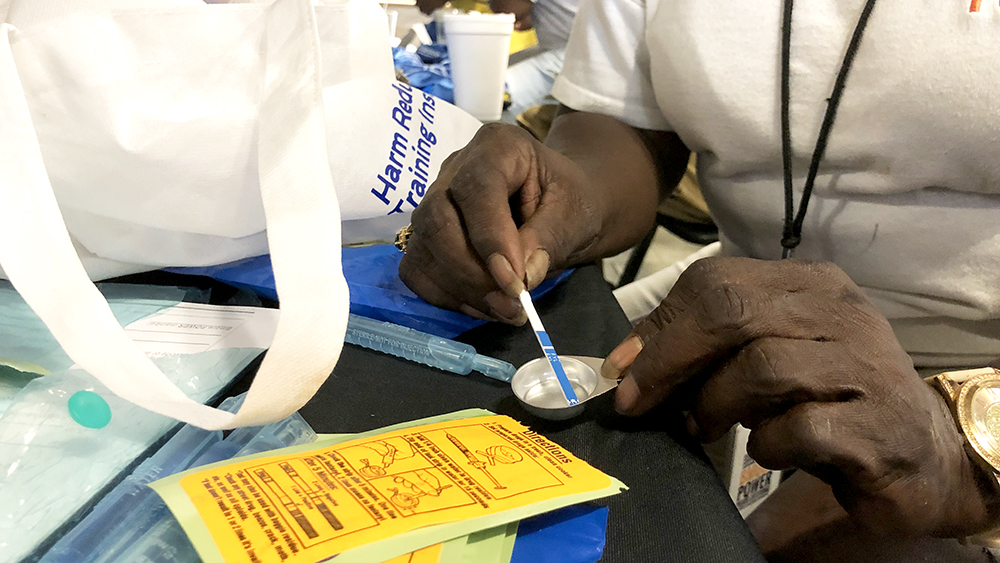ANNAPOLIS, Md.- The mounting number of fentanyl-related overdose deaths has prompted Democratic lawmakers to propose legislation that would pilot creation of safe spaces for drug users to take illegal substances without legal consequences and with medical staff nearby.
Chief sponsor, Del. Joseline Pena-Melnyk, Prince George’s and Anne Arundel, acknowledged that the bill is controversial at a hearing Tuesday afternoon before the House Health and Government Operations Committee, which she chairs.
“People are dying in back alleys by themselves,” she said, in deaths that could be preventable if they were observed. “I hope you open your hearts to try this.”
Forty-six House Democrats are sponsors of HB 0953, also called the Public Health Overdose and Infectious Disease Prevention Services Program. This bill would allow community-based organizations to open up to six centers in non-residential areas where health professionals can monitor users, give first aid and provide sterile needles. The center will also collect used supplies and provide proper disposal. The centers would be distributed equally in urban, rural and suburban areas, according to the bill.
Pena-Melnyk was careful to say that the bill does not constitute a mandate and that each center is an opportunity to bring drug users in for counseling and other services.
Opioids are pain-killing drugs, ranging from prescription pain medicines such as oxycodone, hydrocodone, codeine and morphine, to the synthesized opiate fentanyl, to illegal cheaper substances such as heroin, according to the National Institute on Drug Abuse. When abused, these drugs are highly addictive and can cause severe side effects, especially during withdrawal.
Maryland saw 1,217 fatal opioid overdoses from April 1, 2021, to June 30, 2021, a 1.1% increase from the first six months of 2020, according to the Maryland Opioid Operational Command Center. And although fatal overdoses have declined in the state following increases during the COVID-19 pandemic, the problem remains significant. In 2020, fatal overdoses increased by 17.7% annually, according to the center’s dashboard. In the 12 months ending in October 2022, there were 13.1% fewer fatal overdoses than in the previous 12 months. From October 2021 to October 2022, fentanyl was responsible for 81.5% of all overdose deaths.
Fentanyl is a synthetic opioid used in medical settings and is commonly misused due to its high potency, according to the National Institute on Drug Abuse. Tiny amounts of fentanyl can create powerful highs, making it appealing to addicts.
Ronald Phillips, lead recovery coach at Baltimore’s Center for Youth and Families, said he’s performed more than 50 overdose reversals in five years, but it’s the ones he can’t save that haunt him.
“I am traumatized by the look when people lose their lives from the horrible substance of fentanyl,” he told the committee. “I have it stored in my head the horrors I’ve faced when I was an outreach worker distributing Narcan,” an overdose reversal drug. He said it’s a “must” that the state approve the pilot program for these safe spaces to prevent more deaths.
Besides supervising drug use, these prevention service centers would educate people on the hazards of drug use, give patients access to naloxone (an overdose reversal drug), and coordinate with substance abuse outreach programs and other community-based organizations for treatment.
The cost of the program would be minimal, according to the Department of Legislative Services’ fiscal and policy note on the bill. The Maryland Department of Health can likely implement the program using existing resources and staffing to reduce costs. Insurance carriers for those who use the program will be billed accordingly.
“In Maryland, we have lost over 2,000 individuals to unintentional overdoses each year since 2020. Fentanyl continues to be the primary driver of overdose mortality in Maryland in the last 12 months ending in September 2022,” said Pena-Melnyk to Capital News Service. “Fentanyl was involved in 80.8% of all fatal overdoses. This, right here, is a proven public health solution that addresses the overdose crisis.”
Pena-Melnyk first introduced this bill in 2020 along with now-Sen. Shelly Hettleman, Baltimore County. Pena-Melnyk recently visited a prevention center in East Harlem, New York, to better understand how these centers are implemented in communities ridden with addiction.
“People walk in; they’re in a safe, sterile, clean environment. They’re supervised by experts; they can get counseling if they want… It’s a holistic way of treating this addiction,” said Pena-Melnyk. She told the committee that in the nearly 40 years that such centers have been operating worldwide, they have had no deaths.
The bill has support from various advocacy groups, such as the Maryland Coalition of Families. This organization provides peer mentor support for families caring for a loved one with mental health issues, gambling problems or substance use disorders. Another part of their mission is to advocate for policy and reform, aiding these issues.
“About half the substance-use families we serve have a loved one with an opioid use disorder,” said Ann Geddes, the director of public policy for the Maryland Coalition of Families. “These families are desperate for their loved one to get help; they live in fear that they’re gonna get this call that their child has overdosed.”
The Maryland Coalition of Families has strongly supported HB 953, saying that the bill is a step in the right direction to mitigate the drug epidemic.
“If you look internationally where these sites have been established, there’s just no evidence that they have made the problem worse, only evidence that they help,” said Geddes to Capital News Service. “The importance of not just going someplace to consume a substance safely, but going someplace where you can be connected to services, or you can develop a trusting relationship with somebody who’s going to connect you to services, is a really important aspect of the program.”
This story has been corrected to fix the spelling of Sen. Shelly Hettleman’s name.

